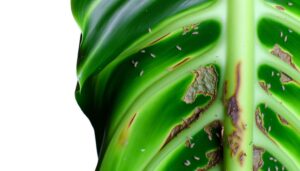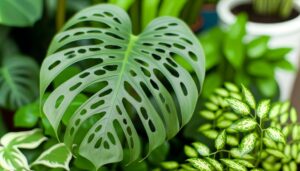Monstera Standleyana Albo Leaves Curling
Your Monstera Standleyana Albo's leaves curl due to stress from improper care. Check your watering practices; overwatering causes root rot while underwatering leads to dehydration.
Maintain humidity at 60-80% and avoid sudden temperature changes. Guarantee the plant gets indirect light and rotate it for even exposure.
Use well-draining, nutrient-rich soil and fertilize appropriately. Regularly inspect for pests like Xanthomonas and manage with neem oil.
Use the right pot size with proper drainage and trim no more than 20% of foliage using sterilized tools. Each of these factors significantly influences leaf health and curling.
Optimize these conditions for robust growth.

Key Takeaways
- Ensure proper watering by checking soil moisture regularly to prevent overwatering and underwatering.
- Maintain ideal humidity levels between 60-80% to prevent leaf curling.
- Provide sufficient indirect light exposure and avoid excessive direct sunlight.
- Use a well-draining, nutrient-rich soil mix and fertilize appropriately during the growing season.
- Regularly inspect for pests and diseases, and use insecticidal soap or neem oil for management.
Watering Issues
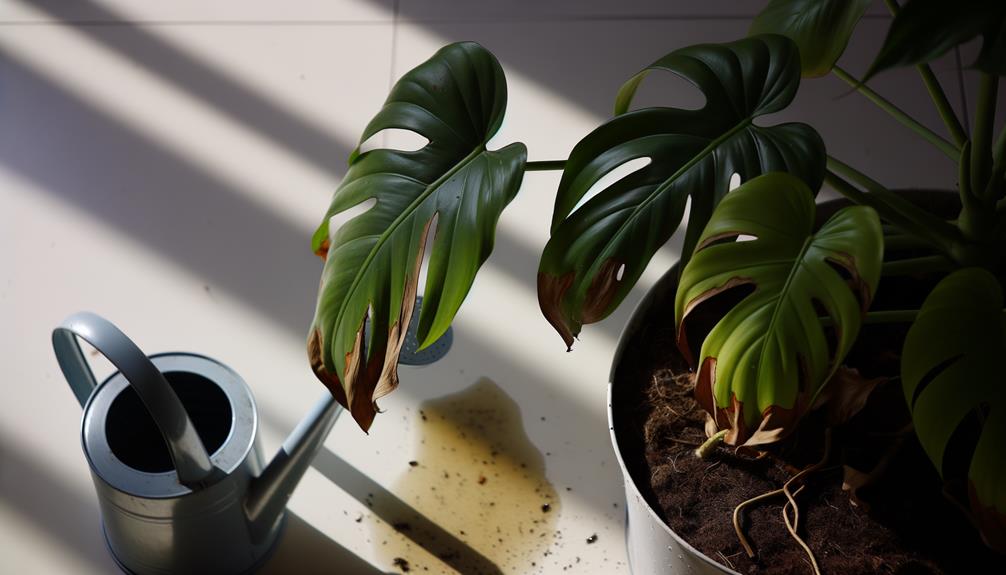
Improper watering practices, either overwatering or underwatering, can directly cause the leaves of your Monstera Standleyana Albo to curl. When you overwater, the roots become waterlogged, leading to oxygen deprivation and root rot. This condition impairs the plant's ability to absorb essential nutrients, causing the leaves to curl as they suffer from nutrient deficiencies.
Conversely, underwatering deprives the plant of necessary moisture, leading to dehydration. Dehydrated leaves lose turgor pressure, making them curl to reduce surface area and minimize water loss.
To avoid these issues, check the soil moisture regularly. Verify the top inch of soil is dry before watering. Use well-draining soil and pots with drainage holes to maintain optimal moisture levels, preventing leaf curl caused by watering errors.
Humidity Levels
Humidity levels play a crucial role in maintaining the health of your Monstera Standleyana Albo. Insufficient humidity can cause the leaves to curl and lose their vibrant appearance. Ideal humidity for this plant ranges between 60-80%. When levels drop below this range, the plant's stomata close to conserve water, leading to leaf curling.
To maintain peak humidity, consider these methods:
- Humidifiers: Use a humidifier to keep the air moist, especially during dry winter months.
- Misting: Regularly mist the leaves with water to increase humidity around the plant.
- Pebble Trays: Place the pot on a tray filled with water and pebbles to allow gradual evaporation and localized humidity.
These strategies will help guarantee your plant thrives.
Temperature Stress
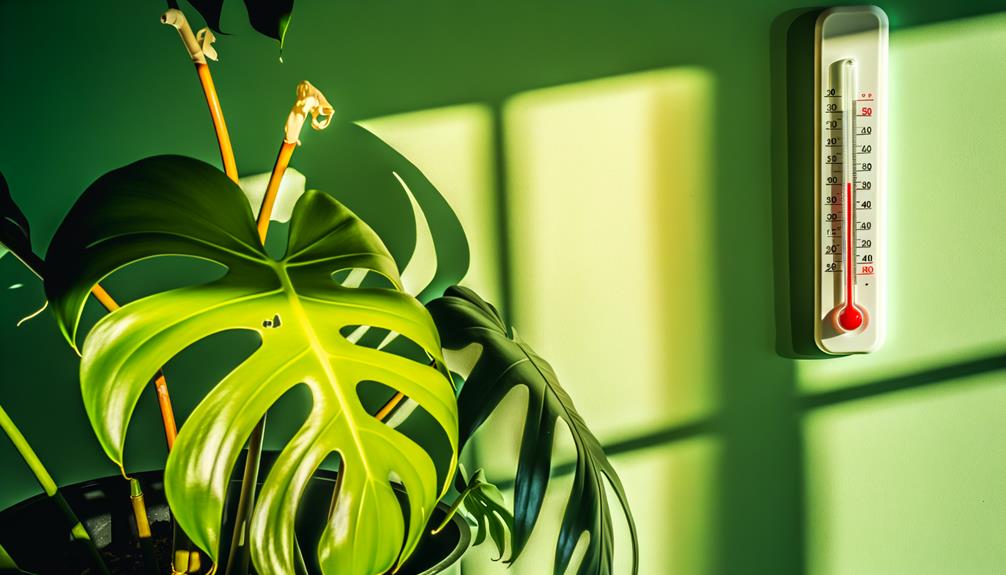
You need to maintain an ideal temperature range of 65-80°F for Monstera Standleyana Albo to prevent leaf curling.
Sudden temperature changes, especially drops, can cause significant stress to the plant.
Look for heat stress symptoms like leaf discoloration and curling edges as indicators of temperature-related issues.
Optimal Temperature Range
Maintaining Monstera Standleyana Albo within an ideal temperature range of 65-80°F is critical to prevent temperature stress that can result in leaf curling. This tropical plant thrives when kept in stable conditions. Deviations from this range can cause physiological stress, manifesting as curling leaves, reduced growth, and susceptibility to diseases. Importantly, temperature extremes disrupt cellular function and photosynthesis, impairing overall plant health.
Here are three key points to remember:
- Monitor Temperature: Use a reliable thermometer to maintain consistent indoor temperatures.
- Avoid Drafts: Position the plant away from vents, windows, and doors to prevent exposure to fluctuating temperatures.
- Humidity Matters: Together with temperature, maintaining high humidity levels (60-70%) can enhance plant resilience and prevent curling.
Sudden Temperature Changes
Rapid changes in temperature can impose significant pressure on Monstera Standleyana Albo, leading to disruptions in cellular processes and subsequent leaf curling. When temperatures shift suddenly, the plant's ability to regulate water and nutrient uptake can become compromised. This sudden environmental stress can cause stomata to close, limiting transpiration and gas exchange.
As a result, cellular turgor pressure drops, causing the leaves to curl as they lose rigidity. Temperature swings can also impact enzyme functions, hindering metabolic activities essential for growth and health. To address this, monitor indoor temperatures closely and avoid placing your Monstera near windows or doors where drafts are common.
Maintaining a stable environment is essential for preventing temperature-induced stress and preserving leaf integrity.
Heat Stress Symptoms
Exposure to prolonged high temperatures can trigger a cascade of physiological reactions in Monstera Standleyana Albo, manifesting as leaf curling and other symptoms of heat stress. When temperatures rise above the plant's ideal range, its metabolic processes can become disrupted. This can lead to increased transpiration rates, causing the leaves to lose moisture faster than they can absorb it. Ultimately, this imbalance results in curling leaves as the plant tries to conserve water.
To effectively identify heat stress, look for these signs:
- Leaf Edges Browning: Heat stress often causes the leaf margins to turn brown and crispy.
- Wilting: Despite adequate watering, the plant may appear wilted due to rapid water loss.
- Stunted Growth: High temperatures can inhibit overall growth and development.
Understanding these symptoms will help you better care for your Monstera Standleyana Albo.
Light Conditions
Light conditions play a critical role in the health of your Monstera Standleyana Albo. Insufficient natural light can lead to curling leaves as the plant struggles to photosynthesize effectively.
Conversely, excessive direct sunlight can cause leaf burn and stress, further contributing to curling.
Insufficient Natural Light
When Monstera Standleyana Albo lacks adequate natural light, its leaves will start curling as a stress response to insufficient photosynthesis. Photosynthesis is crucial for your plant's energy production, and without enough light, the process falters.
You'll notice the leaves curling inward to minimize surface area and reduce water loss.
To correct this issue, you can:
- Increase light exposure: Position your plant near a north or east-facing window where it can receive indirect sunlight.
- Supplement with grow lights: Use full-spectrum grow lights to provide the necessary light wavelengths.
- Rotate the plant: Ensure uniform light distribution by rotating the plant weekly.
Excessive Direct Sunlight
Excessive direct sunlight causes Monstera Standleyana Albo leaves to curl as a defense mechanism against the intense light, which can lead to leaf burn and dehydration. When this plant is exposed to too much sunlight, the leaf cells lose water rapidly, causing desiccation.
The curling reduces the surface area exposed to the sun, minimizing water loss and preventing further damage to the chlorophyll. You should monitor the plant's light exposure and consider relocating it to a spot with bright, indirect light.
Direct sunlight for prolonged periods can also disrupt the photosynthesis process, reducing the plant's overall health. Utilizing sheer curtains or placing the plant near east-facing windows can provide the best light conditions it needs to thrive without curling.
Soil Quality
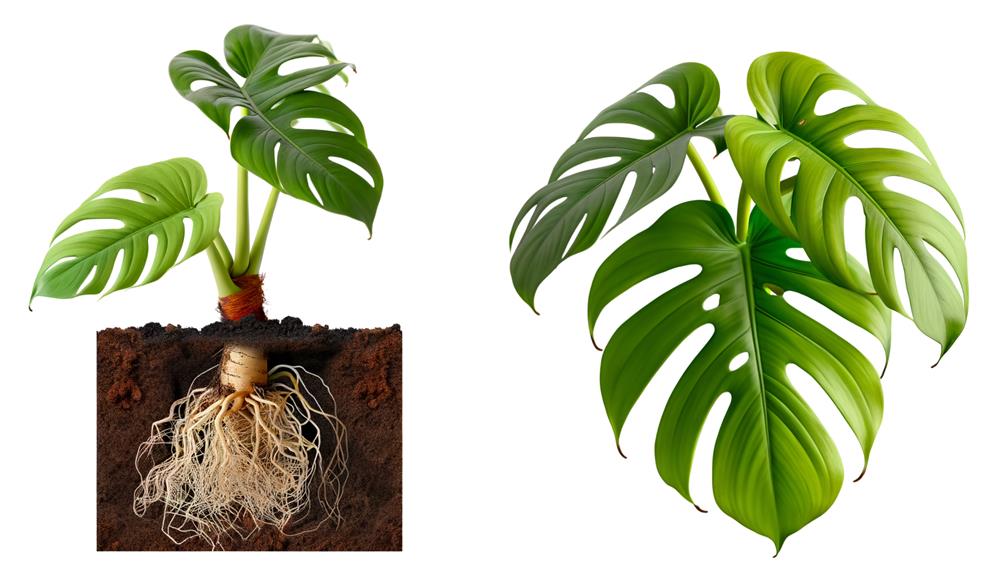
Proper soil quality is essential for preventing leaf curling in Monstera Standleyana Albo. You need well-draining, nutrient-rich soil to ensure ideal growth. Poor soil can lead to water retention, root rot, and nutrient deficiencies, all of which cause leaf curling.
Here's what you should do:
- Choose a soil mix: Use a blend of peat moss, perlite, and orchid bark. This mix provides aeration and drainage.
- Check soil pH: Maintain a slightly acidic to neutral pH (5.5 to 7). You can use a pH meter for accuracy.
- Fertilize appropriately: Apply a balanced, water-soluble fertilizer every 4-6 weeks during the growing season to replenish essential nutrients.
These steps will help maintain the health of your Monstera Standleyana Albo.
Pests and Diseases
Pests and diseases can significantly contribute to leaf curling in Monstera Standleyana Albo by disrupting the plant's physiological processes and overall health. Aphids, spider mites, and scale insects siphon sap, leading to dehydration and stress, which appears as curled leaves.
Fungal infections like powdery mildew and root rot hinder nutrient and water uptake, worsening the problem. Bacterial pathogens, such as Xanthomonas, cause leaf spots and tissue decay, further compromising leaf integrity.
Regularly inspect your plant for early signs of infestations or infections. Use insecticidal soap or neem oil to manage pests. For fungal and bacterial issues, maintain proper air circulation and avoid overwatering. Promptly remove affected leaves to prevent the spread of pathogens.
Nutrient Deficiency
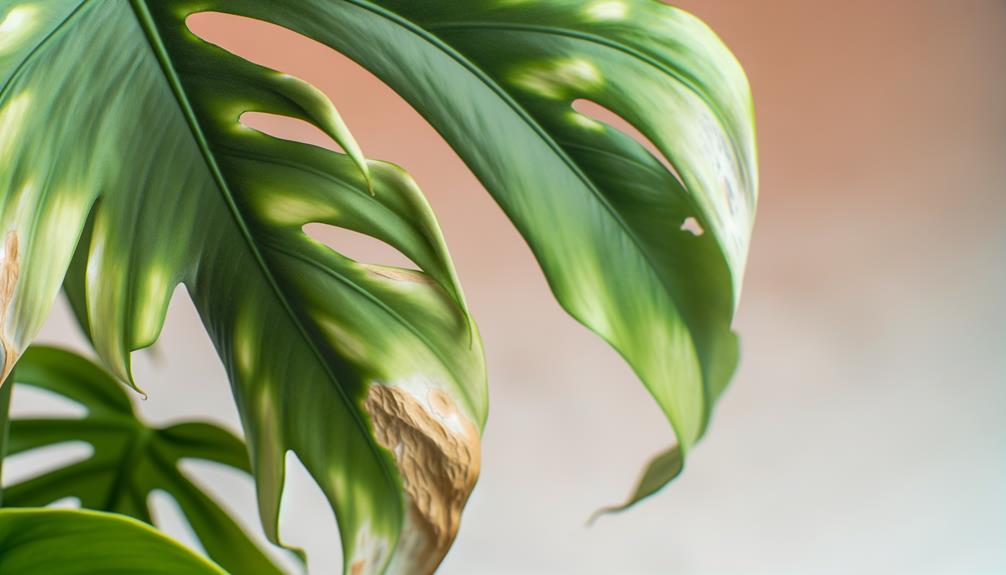
In addition to pest and disease issues, nutrient deficiencies can also cause Monstera Standleyana Albo leaves to curl by disrupting essential metabolic processes and weakening the plant's structural integrity. You need to make sure that your plant gets a balanced supply of essential nutrients.
Here are three key nutrients to focus on:
- Nitrogen (N): A deficiency in nitrogen can lead to stunted growth and curled leaves as it's vital for chlorophyll production and cellular functions.
- Phosphorus (P): Lack of phosphorus impairs root development and energy transfer, leading to weak, curling leaves.
- Potassium (K): Insufficient potassium can cause poor water regulation and weakened cell walls, resulting in leaf curl.
Regularly check soil nutrient levels and adjust as needed to maintain plant health.
Pot Size
Choosing an appropriately sized pot is crucial for your Monstera Standleyana Albo's root development and overall health. An oversized pot can lead to waterlogging and root rot, while an undersized pot restricts root expansion and nutrient uptake. It's vital to select a pot that allows adequate drainage and has enough room for growth.
Here's a quick reference to guide your choices:
| Pot Size (inches) | Plant Height (feet) |
|---|---|
| 4-6 | 1-2 |
| 6-8 | 2-3 |
| 8-10 | 3-4 |
| 10-12 | 4-5 |
| 12+ | 5+ |
Ensuring the right pot size helps maintain the best soil moisture levels, promoting vigorous foliage and preventing leaf curling. Choose wisely to nurture your Monstera Standleyana Albo effectively.
Improper Pruning

Improper trimming can stress your Monstera Standleyana Albo to a great extent, leading to undesirable leaf curling and stunted growth. By removing too many leaves or stems at once, you disrupt the plant's photosynthesis process and nutrient distribution. Always use sterilized tools to prevent infections and ensure clean cuts.
Follow these guidelines for best trimming:
- Trim Sparingly: Remove no more than 20% of the foliage at any time to prevent shock.
- Target Dead or Yellowing Leaves: Focus on trimming damaged or unhealthy parts to promote healthier growth.
- Trim During Active Growth: Perform trimming in spring or early summer when the plant is most resilient.
Conclusion
Just like a detective piecing together clues, solving the mystery of your Monstera standleyana albo's curling leaves requires a methodical approach. Make sure you're watering correctly, maintaining peak humidity and temperature, and providing ample light.
Check soil quality, inspect for pests, and address nutrient deficiencies. Evaluate pot size and pruning practices. By systematically addressing these factors, you can restore your plant's health and enjoy its lush beauty.
Your attentive care will yield vibrant, uncurling leaves.

